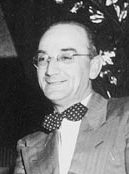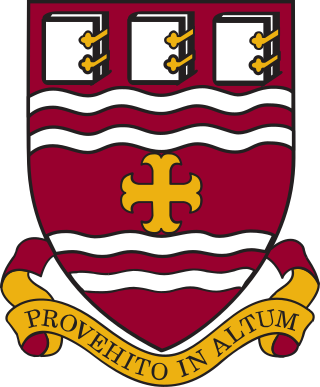Related Research Articles

Joseph Roberts Smallwood was a Newfoundlander and Canadian politician. He was the main force who brought the Dominion of Newfoundland into Canadian Confederation in 1949, becoming the first premier of Newfoundland, serving until 1972. As premier, he vigorously promoted economic development, championed the welfare state, and emphasized modernization of education and transportation. The results of his efforts to promote industrialization were mixed, with the most favourable results in hydroelectricity, iron mining and paper mills.

Memorial University of Newfoundland, also known as Memorial University or MUN, is a public research university in the province of Newfoundland and Labrador, based in St. John's, with satellite campuses in Corner Brook, elsewhere in Newfoundland and in Labrador, Saint Pierre, and Harlow, England. Memorial University offers certificate, diploma, undergraduate, graduate, and post-graduate programs, as well as online courses and degrees.
Edward Moxon Roberts was a Canadian lawyer and politician. He first served as a member of the Newfoundland and Labrador House of Assembly (MHA) from 1966 to 1985 representing White Bay North, and again from 1992 to 1996 representing Naskaupi. He went on to serve as the eleventh lieutenant governor of Newfoundland and Labrador from 2002 until 2008.
Paul Jolliffe Johnson, ONL was a businessman and philanthropist born St. John's, Newfoundland, the son of Marjorie (Jolliffe) and Arthur Johnson. He was educated at Prince of Wales College, King's College, Mount Allison Academy and Mount Allison University.
Elmer Frank Harris, is a noted Canadian humanitarian.
Frederick William Rowe was a Canadian politician and Senator.
The Barrelman was a name adopted by Joseph Smallwood for his fifteen-minute radio program on the Broadcasting Corporation of Newfoundland to promote pride in Newfoundland's history and culture. The show began as a column in the Daily News newspaper, and later appeared as a radio show on St. John's radio station VONF in 1937 and became part of BCN's schedule when the network was established two years later. Within a week of its 1937 premiere, it had gathered an appreciative audience that it caught the attention of F.M. O'Leary Limited who began sponsoring it. The program was aired six nights a week and remained on the air for seven years.
The Smallwood Reservoir is the reservoir created for the Churchill Falls Generating Station in the western part of Labrador, Canada. Unlike other reservoirs, water is contained not by a single large dam, but by a series of 88 dikes that total 64 km (40 mi) in length in the drainage area of the Churchill River. It is named in honour of Joey Smallwood, the first premier of Newfoundland.

The province of Newfoundland and Labrador covers the period from habitation by Archaic peoples thousands of years ago to the present day.

English Harbour East is a town in the Canadian province of Newfoundland and Labrador. It is located on the northeast side of Fortune Bay. Settled first by the Mi’kmaq of Newfoundland which used land on the "Neck" of the Harbour, they were joined in the early 1800s, by the English Dodge family and by Irishman Thomas Hynes Sr. European fishermen were first brought to the small community by English merchant family of Newman and Co. based in Harbour Breton, the firm of merchant John Gorman, and the Jersey firm of Nicholle and Co. The town had a population of 117 in the Canada 2021 Census.
John Rowland Courage was an educator, lawyer and political figure in Newfoundland. He represented Fortune Bay and Hermitage in the Newfoundland and Labrador House of Assembly from 1949 to 1962 as a Liberal.
Haystack was a former fishing settlement located on the northern portion of Long Island, Placentia Bay of the island of Newfoundland in the province of Newfoundland and Labrador, Canada. People from the community freely chose to move to other places in the province during the resettlement program of the 1950s and 60s. Unlike most communities, residents were not paid to leave the community.
Arthur Raymond Lundrigan, OC, LL.D., D.Eng. was a Canadian businessman based in Newfoundland and Labrador, involved in the development and construction of such projects as the Bay d'Espoir Hydroelectric Power Station, the Churchill Falls Generating Station, and the Come By Chance Refinery.

The members of the 29th General Assembly of Newfoundland were elected in the Newfoundland general election held in June 1949. The general assembly sat from July 11, 1949 to November 3, 1951. This was the first general election held in Newfoundland since the assembly was replaced by an appointed Commission of Government in 1934. Newfoundland had joined Canadian confederation in March 1949.

The members of the 31st General Assembly of Newfoundland were elected in the Newfoundland general election held in October 1956. The general assembly sat from March 19, 1957, to July 28, 1959.

The members of the 32nd General Assembly of Newfoundland were elected in the Newfoundland general election held in August 1959. The general assembly sat from April 20, 1960, to October 23, 1962. The assembly moved to the newly constructed Confederation Building in 1960.

The members of the 34th General Assembly of Newfoundland were elected in the Newfoundland general election held in September 1966. The general assembly sat from November 30, 1966, to October 4, 1971.
Newfoundland Quarterly is a literary magazine published by Memorial University of Newfoundland in St. John's, Newfoundland and Labrador, Canada. Having begun as "a literary magazine of interest to Newfoundlanders at home and abroad," Newfoundland Quarterly today calls itself "a cultural journal of Newfoundland and Labrador", and publishes articles on the province's culture and history, including biography, local history, book reviews, visual art and poetry. Founded in 1901, it is Canada's longest running magazine.